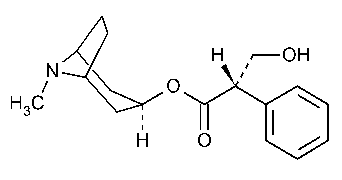Hyoscyamine
Benzeneacetic acid,a-(hydroxymethyl)-,8-methyl-8-azabicyclo[3.2.1]oct-3-yl ester,[3(S)-endo-].
1aH,5aH-Tropan-3a-ol (-)-tropate (ester). [101-31-5].
»Hyoscyamine contains not less than 98.0percent and not more than 101.0percent of C17H23NO3,calculated on the dried basis.
Packaging and storage—
Preserve in tight,light-resistant containers.
Identification—
A:
Transfer 30mg of Hyoscyamine and 36mg of USP Hyoscyamine Sulfate RSto individual 60-mLseparators with the aid of 5-mLportions of water.To each separator add 1.5mLof 1Nsodium hydroxide and 10mLof chloroform.Shake for 1minute,allow the layers to separate,and filter the chloroform extracts through separate filters of about 2g of anhydrous granular sodium sulfate supported on pledgets of glass wool.Extract each aqueous layer with two additional 10-mLportions of chloroform,filtering and combining with the respective main extracts.Evaporate the chloroform solutions under reduced pressure to dryness,and dissolve each residue in 10mLof carbon disulfide:the IRabsorption spectrum,determined in a 1-mm cell,of the solution obtained from the test specimen exhibits maxima only at the same wavelengths as that of the solution obtained from the Reference Standard.
B:
Dissolve 60mg in 1mLof 0.2Nhydrochloric acid,and add gold chloride TS,dropwise with shaking,until a definite precipitate separates.Add a small amount of 3Nhydrochloric acid,dissolve the precipitate with the aid of heat,and then allow to cool:lustrous golden yellow scales are formed (distinction from atropine and scopolamine).
Specific rotation á781Sñ:
between -20 and -23
and -23 .
.
Test solution:
10mg per mL,in dilute alcohol (1in 2).
Loss on drying á731ñ—
Dry it in vacuum over silica gel to constant weight:it loses not more than 0.2%of its weight.
Residue on ignition á281ñ:
not more than 0.1%.
Limit of foreign alkaloids and other impurities—
Prepare a solution of it in methanol containing 20mg per mL,and by quantitative dilution of a portion of this solution with methanol,prepare a second solution of Hyoscyamine containing 1mg per mL.Apply 25µLof the first (20mg per mL)Hyoscyamine solution,1µLof the second (1mg per mL)Hyoscyamine solution,and 5µLof a methanol solution of USP Hyoscyamine Sulfate RScontaining 24mg per mLto a suitable thin-layer chromatographic plate (see Chromatography á621ñ)coated with a 0.5-mm layer of chromatographic silica gel.Allow the spots to dry,and develop the chromatogram in a solvent system consisting of a mixture of chloroform,acetone,and diethylamine (5:4:1)until the solvent front has moved about three-fourths of the length of the plate.Remove the plate from the developing chamber,mark the solvent front,and allow the solvent to evaporate.Locate the spots on the plate by spraying with potassium iodoplatinate TS.The RFvalue of the principal spot obtained from each test solution corresponds to that obtained from the Standard solution,and no secondary spot obtained from the first Hyoscyamine solution exhibits intensity equal to or greater than the principal spot obtained from the second Hyoscyamine solution (0.2%).
Assay—
Dissolve about 500mg of Hyoscyamine,accurately weighed,in 50mLof glacial acetic acid,add 1drop of crystal violet TS,and titrate with 0.1Nperchloric acid VSto a green endpoint.Perform a blank determination,and make any necessary correction.Each mLof 0.1Nperchloric acid is equivalent to 28.94mg of C17H23NO3.
Auxiliary Information—
Staff Liaison:Elena Gonikberg,Ph.D.,Scientist
Expert Committee:(PA4)Pharmaceutical Analysis 4
USP28–NF23Page 985
Phone Number:1-301-816-8251
